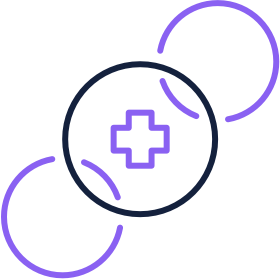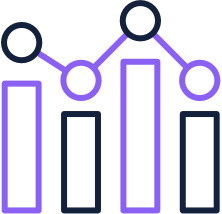Explore an asset’s potential to clear all technical and regulatory hurdles and receive FDA approval.

Assess current pipeline with real-time AI-driven PTRS for faster, more confident decisions.

Gain transparency and context with AI Explainability with PTRS drivers to understand the impact they have on the assessment.

See phase transition and PTRS for industry-led, interventional FDA-track trials, including that of competitors.

Explore how a specifc drug or combinations of drugs advance through clinical development phases

Access comprehensive, granular, disease-specific benchmarks.

View clinical outcomes by phase, arm and cohort and access primary and secondary endpoints to understand clinical design by specific indication.
Together, Let’s Drive Your Strategic Portfolio Management Forward
Increase R&D ROI
Save between $8-25M* per year, by reducing the number of failed Phase 2 and Phase 3 trials.
- Augment internal discussions consistently and calibrate PTRS assessments across assets
- Save resources associated with PTRS elicitation and calibration
- Challenge internal thinking and reduce subjectivity and biases
- Improve resource allocation by stopping less-promising projects early
*Based on failed trials only in oncology and I&I
**Based on blockbuster drug
Accelerate Time to Market
Save between $2-5M per month of delayed launch of a single asset** by accelerating investment decision-making.
- Reduce number of risk elicitation and alignment meetings
- Increase data and explainability transparency
- Make faster decisions and accelerate execution speed
*Based on failed trials only in oncology and I&I
**Based on blockbuster drug
Make Smarter Deals
Save between $3-5M per in-licensing deal in upfront payments for every 5% points of miscalculated PTRS.
- Apply the same level of rigor for internal assets
- Reduce information asymmetry during valuation
- Reduce number of missed-out opportunities due to risk over-estimation
*Based on failed trials only in oncology and I&I
**Based on blockbuster drug

Challenge
Expensive and time-consuming expert elicition and KOL process.

Solution
Leverage Portfolio Optimizer to complement and enhance internal process with consistent and comprehensive data.

Benefits
Save valuable resources while minimizing manual effort and human bias.

Challenge
Limited data and high risk on early stage licensing. High-costs and competition on later stage assets.

Solution
Use Portfolio Optimizer to compare PTRS of various candidates, assess them against objective benchmarks, and compare the competitive landscape to support your valuation efforts.

Benefits
Identify promising assets earlier and more confidently by incorporating data-driven probability of success assessment to support your business case and negotiations.

Challenge
Lack of consistent and comprehensive benchmarking data make for difficult decisions on which drug candidates to move forward.

Solution
Use Portfolio Optimizer to inform decisions on therapeutic area expansion, indication and phase benchmarking to rank drug development opportunities.

Benefits
Leverage objective assessments to generate a list of prioritized assets and foster internal alignment and understand where your asset fits in the competitive landscape.
Our Industry-Leading Accuracy Is Validated With Four Distinct Methods
Our Industry-Leading Accuracy Is Validated With Four Distinct Methods
Retrospective Accuracy
Area under the curve (AUC) is a metric which indicates whether the model assigns higher probability to the approved programs higher than the failed ones. The higher the AUC the better.
Sensitivity/ Specificity
The True Positive (sensitivity) and True Negative (specificity) rates highlight the ability of the model to correctly identify approved and rejected programs, accordingly. The higher the rates the better.
Brier Score Loss
Brier Score Loss (BSL) is a metric that quantifies the accuracy of probability predictions. BSL penalizes high probabilities of failed programs and low probabilities of approved programs. The lower the BSL the better.
Prospective Accuracy
The Calibration Curve measures prospectively how closely the predicted probabilities match the actual and observed outcomes, helping to understand the reliability of the model.

Access to depth and breadth of data based on unique program entity that goes beyond the molecule-indication level.

See both phase-by-phase and path-by-path analyses for better facilitating data-driven decision-making that captures a more comprehensive view of the clinical development path.

Customize your search with dynamic filtering to slice-and-dice data and surface relevant, real-time data.














